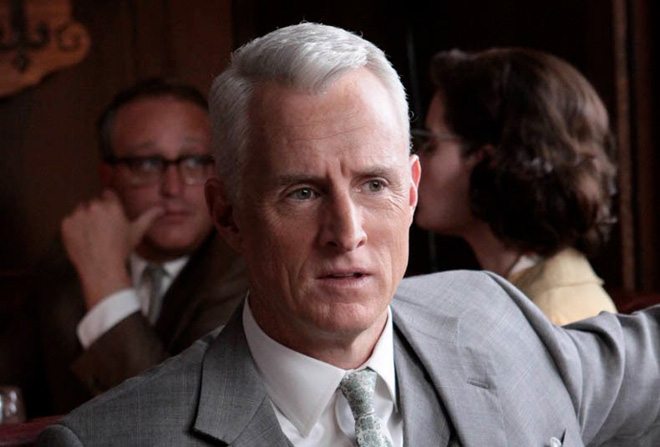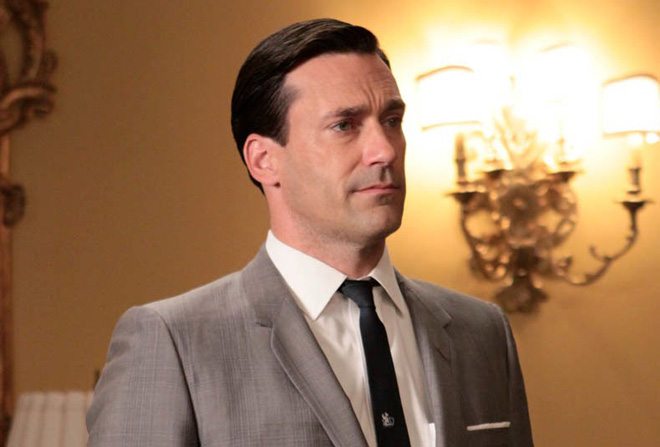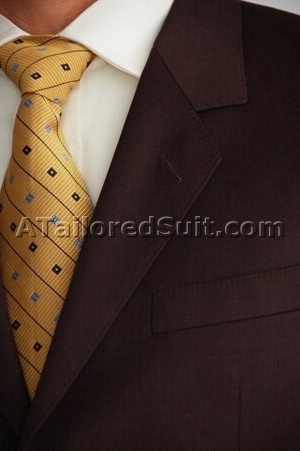Any sport tailor made suits will look good with a variety of pants. Better, though,
that you own a variety of sport coats, and keep the pants simple and
functional. Gray flannels go brilliantly with any jacket, and without
compromising its versatility or allure. They will last for years, and
like the classic navy blazer, they will never go out of style.
Pants should not be the focal point of a man's outfit; rather, a
trouser's job is to quickly draw the eye upward to your sport jacket or
downward to your dress shoes, and perhaps subtly flatter your legs.
The fact is most men are better served highlighting another part of
their body. Additionally, since the legs move next to each other, a
pattern that appears elegant on the torso such as herringbone or windowpane can easily become jarring below it. It is no wonder, therefore, that virtually all men's trousers sold today are solid in color. Thus the beauty of men's solid gray (or grey) flannel trousers - simple
More Info:
http://mansuits123.blogspot.com/2013/06/suit-jacket-waist-buttons.html
Sunday, June 30, 2013
Monday, June 24, 2013
Suit Jacket Waist Buttons
Where the lapels end, one finds the waist buttons. As previously indicated, a suit jacket has either one row of buttons or two, depending on whether it is single- or double-breasted. A single-breasted jacket has a single row of buttons, numbering anywhere from one to four, though two and three are most standard, while a single-button is generally limited to the tuxedo. The three-button jacket, although a sometimes unfamiliar garment to those unaccustomed to wearing bespoke suit, is the most traditional configuration, taking its cue from English riding jackets; properly worn, it gives the illusion of height. Traditionally, only the middle or second button is fastened when standing, though the top two buttons may be fastened to produce a slightly more formal appearance. Two-button suits are a slightly later innovation, and because they show more of the shirt and tie, can produce a slightly more slimming appearance. Only the top button of a two-button jacket is fastened; with the exception of a jacket with only one button, the bottom button of a single-breasted jacket is never fastened.
Four-button jackets are somewhat
more rare than the other options, but are an elegant choice for the
very tall man; because of his height, a four-button suit on a very tall
man emulates the look of a three-button jacket on a shorter man. It is
very common to see professional basketball players wearing four-button
suits; the loud colors and wild patterns often chosen by celebrities,
however, should be avoided by the gentleman. Unlike two- and
three-button suits, where the bottom button is left undone, a
four-button jacket is worn with all four buttons fastened.
Double-breasted jackets most
commonly have either four or six buttons on each side – where there are
six buttons, only the lower four are for buttoning, though due to the
design of the suit, only two will actually be buttoned at any given
time. There is also an extra hidden button on the reverse of the
outside flap of a double-breasted suit, onto which the inside or
"hidden" flap attaches. Contrary to the habits of certain celebrities, a
double-breasted jacket is never left unbuttoned when standing,
permitting it to flap around wildly; it is always securely buttoned
upon standing and remains buttoned until one is again seated.
Additionally, while the bottom button of a single-breasted suit is
always left undone, both of the operable buttons on a double-breasted
jacket are fastened. As with the gorge of the lapel, the height of the
waist buttons can be altered slightly to accentuate or diminish height,
but this must be done carefully.
Sunday, June 23, 2013
Button and French cuffs
The choice of ones cuff type is a
very important detail and should be chosen with the intended use of the dress shirt in mind. Though not everyone requires a closet full of French
cuffed shirts, a gentleman should have at least one for those occasions
when he wants to appear just a bit more stylish than the ordinary.
Embracing this elegant look is an excellent way to declare to all
observers that one not only takes pride in his appearance, but also has
an appreciation for subtle elegance.
 Button Cuffs
Button Cuffs
Button cuffs are single cuffs, which wrap around the arm and are buttoned into place. The most common button cuffs have a single button or may be adjustable, with two buttons side-by-side. These are the cuffs most commonly found on ready made shirts. In custom shirt circles you'll find dress shirt cuffs with two buttonholes and two vertical buttons, a more formal option often called the barrel cuff. Button cuffs may also have a small button on the sleeve between the cuff and the end of the cuff opening. Called the gauntlet button, this smaller button is intended to prevent the area from opening and exposing the gentleman's wrist. Gauntlet buttons are a sign of a quality made shirt, a small detail ignored by most off the rack manufacturers.

 Button Cuffs
Button CuffsButton cuffs are single cuffs, which wrap around the arm and are buttoned into place. The most common button cuffs have a single button or may be adjustable, with two buttons side-by-side. These are the cuffs most commonly found on ready made shirts. In custom shirt circles you'll find dress shirt cuffs with two buttonholes and two vertical buttons, a more formal option often called the barrel cuff. Button cuffs may also have a small button on the sleeve between the cuff and the end of the cuff opening. Called the gauntlet button, this smaller button is intended to prevent the area from opening and exposing the gentleman's wrist. Gauntlet buttons are a sign of a quality made shirt, a small detail ignored by most off the rack manufacturers.

French Cuffs
French cuffs are the most formal cuff option, yet are perfectly appropriate for daily wear in many industries. The French cuff is a double cuff, folded back and fastened with cufflinks to create a distinctive and distinguished appearance. Cufflinks must always be worn with French cuffs – though there are more subtle options available, such as fabric knots – so the gentleman must be prepared to keep a reasonable selection on hand. French cuffs are not made to be rolled up; throw in the phenomenon of cufflinks being prone to disappear, and the French cuff becomes a less attractive option to low maintenance men.
French cuffs are the most formal cuff option, yet are perfectly appropriate for daily wear in many industries. The French cuff is a double cuff, folded back and fastened with cufflinks to create a distinctive and distinguished appearance. Cufflinks must always be worn with French cuffs – though there are more subtle options available, such as fabric knots – so the gentleman must be prepared to keep a reasonable selection on hand. French cuffs are not made to be rolled up; throw in the phenomenon of cufflinks being prone to disappear, and the French cuff becomes a less attractive option to low maintenance men.
Friday, June 21, 2013
Ties
If the shirts of the early 1960s workforce are by necessity plain, the ties surely make up for it. You won’t see any novelty ties — no Mickey Mouse here, though the character existed by the time the show is set — but you will see a wide variety of patterns and colors in the Mad Men wardrobe. Even Harry Crane’s ubiquitous bow ties are colorful. The “skinny tie” look that most of the cast wears is very period, as is the richness of pattern and general preference for muted but varied colors.

Roger Sterling’s tie here is a classic example: the color is pale, but quite separate from anything he’s wearing anywhere else on his body, and the pattern is varied and even a touch elaborate. Since the Mad Men are careful never to wear patterns that are too similar to those of their suits or shirts, they can wear ties that are visually quite “busy” without looking garish or tacky.

And speaking of tacky, how about that nice tie tack (also called a tie pin) Don’s sporting? Several of the Mad Men like to use tacks or clips to brighten up their ties with a bit of a metallic flash.
http://www.matthewaperry.com/
Monday, June 17, 2013
How to choose a dry cleaner for your dress suit
There is not an exact science that tells you when it’s time to take your bespoke suit coat and trousers to the dry cleaner. However, most of us visit the dry cleaners too often. A good rule of thumb is to dry clean your menswear when brushing, airing out and spot cleaning aren’t removing the odors, dirt or stains any more. If you rarely wear a suit, this may be as little as once a year. Of course if you live in your dress suit, you may dry clean more frequently.
Dry clean your dress suit as little as possible. Perc strips the wool fibers of their natural oils. This causes the fibers to become brittle and your dress suit to become worn-though well before its time.
When it comes time to clean your suit, do a bit of homework. Check America’s Best Cleaners, or search Google for any reviews of dry cleaners near you. There is no shortage of dry cleaners, but the ones who have been in business for a while will have both a good following and a good reputation. Take the time to call a few local dry cleaners. If they’re willing to take the time to answer your questions, that may be a sign that you can trust them with your custom suit. Don’t forget to find out if they do their dry cleaning in-house, or send it out to a larger facility. This may not seem like a big deal but it will make a world of difference the first time an item gets misplaced.
Pay attention to how your clothes are handled at intake. A good clerk will mark any spots or problem areas which may need pretreating. Also, be sure to point out any loose buttons. Get a detailed receipt of what you’re dropping off for your records as well. This is a great guide to dry cleaning.
Thursday, June 13, 2013
A guide to the history, style and instructions on tying the Windsor necktie knot
The Windsor knot, or the Full Windsor, is the largest of the four most popular necktie knots. Stemming from the royal heritage of the English, this knot enjoys a large prestige when worn. Therefore it is largely a power knot for business.

A Closer Look at the Windsor Knot
The Windsor is a very large symmetrical triangular shaped knot. While the knot is self-releasing, it does not slip when tied correctly. The loops which form the back of the knot allow a bit of space between the collar line and the necktie making the Windsor very comfortable to wear. However it only works with certain types of men’s shirt collars.
The History of the Windsor Knot
Folklore says that the Windsor was handed down to the royal family from King George V along with the crown jewels. The Windsor knot is often believed to be named after the Duke of Windsor (Edward VIII) who preferred a wider, thicker knot. However, the knot is actually attributed to his grandfather, Edward VII.
The Windsor knot also carries a bit of controversy. In the 20′s and 30′s, America fell in deep infatuation with all things fashionable that the Duke (at that time Prince Edward) did. When the the Windsor knot was demonstrated in 1936 two steps were reversed. This created an impossibly complex knot. Whether created as a hoax, or not has never been truly known. But it has led to the mistaken belief that the Windsor knot is exceedingly difficult to tie. However the steps below show this is not so.
How to Tie the Windsor Knot
Step One: Begin with the wide end of the tie on the right side, quite a bit lower than the narrow end. Because the Windsor uses so much material, try 10 to 12 inches.
Step Two: Cross the wide end over the narrow end. Continue this motion by passing the wide end under the narrow end forming a loop around it. Pull firm.
Step Three: Pass the wide end of the tie under the loop you just made. You will now have the underside of the tie showing on the right side.
Step Four: Loop the wide end of the tie over the narrow end again on the right side. Pull this tight as well. You will now have a loop on either side which begins to look like a triangle.
Step Five: Bring the wide end of the tie over both of the loops from right to left. This will form the front of the triangle.
Step Six: Continue by bringing the wide end of the tie between the necktie and the collar line. Tuck this through the loop that you just formed.
Step Seven: Tighten the knot by pulling down gently on the wide end of the tie with one hand and moving the knot up with the other. Don’t forget to straighten and form the dimple.
Wednesday, June 12, 2013
Menswear for the Short, Heavyset Man: Heel to Head
Patterning Styles for Short, Broad Men
As a stout man, your wardrobe should primarily feature dark, solid colors. Removing the visual clutter of patterns allows well-fitted clothing to move the viewer’s gaze quickly along, sending it up (for height) and out (away from your width). Vertical stripes spaced close together add the most height, if patterns are desired, but dark colors are still imperative; bright dyes pull the eye in and invite it to linger, which is the opposite of your needs. Heavily textured weaves like herringbone or houndstooth are likewise undesirable — as much as possible, err on the side of smooth simplicity.
Shoes for Short Men
Footwear that provides a physical boost, either in the heel or within the shoe’s interior, may or may not add a few extra centimeters to a man’s height. More important is footwear that presents a clean visual line — avoid anything with unnecessary detailing or decorative seams. A plain-toed oxford serves best, and has the added benefit of being acceptable in even the most formal situations; an unadorned loafer will serve well on occasions when an oxford is too dressy. Resist the temptation to add height with a chunky heel, as it will add an unwanted feeling of solidness and breadth to your body (as well as looking like you’re trying too hard).
The Stocky Man’s Trousers
Trousers should be worn as high as possible on the waist, allowing the pants to drape comfortably over your stomach rather than forcing the flesh to hang over a low-slung waistband. A close fit in the crotch will help prevent a shapeless, saggy appearance, and helps create the impression of longer legs and extra height as well. Cuffs at the bottom of the trouser legs add little to your appearance and break the smooth, vertical line, and should therefore be avoided. Pleats, on the other hand, will loosen the pants about the waist and hips and add a subtle vertical element as well. Fasten your trousers with a pair of suspenders, not a belt — the belt breaks your vertical shape in half and draws the eye directly to your middle, and the suspenders will be more comfortable besides.
A Suit Coat for the Short, Stocky Man

A deep, narrow V-shape lengthens your chest and slims your torso.
Whenever possible, choose coats with peak lapels; these help guide the eye upward and have the added advantage of standing out as somewhat unusual in today’s fashions.
http://www.matthewaperry.com/Product/SUITS.html
Tuesday, June 4, 2013
Basics of Fit
Nothing is more important in constructing your appearance than fit. Well-fitted garments follow the lines of the body without hugging them tightly, while poorly-fitted ones sag or pinch; the best-fitted garments will emphasize a man’s best lines and disguise the rest. There is no substitute here for custom work — unless you happen to share the exact measurements of the model used to program the machines, a mass-produced article is going to fit poorly in at least one way, and likely more than one. Seek out a tailor you feel comfortable with, and ask them to help create a cut that bespoke suits your body.
In general, adjustments and details are designed to heighten the viewer’s awareness of the wearer’s physical strengths. Thin men can benefit from wider cuffs, broad men from high waists; tall men treasure low-notched lapels while short men will want their jackets cut short in the back to lengthen the presence of their legs. These are the details that tailors earn their living with — find one who will talk frankly about options for your body type, rather than simply recommending a similar pattern to every customer and adjusting only the measurements. True custom tailoring (also called “bespoke”) will include consideration of fabrics, patterns, pocket styles, venting, and more — all of these should be discussed in the context of your body and your look.
http://www.matthewaperry.com/Product/SUITS.html
Subscribe to:
Comments (Atom)
